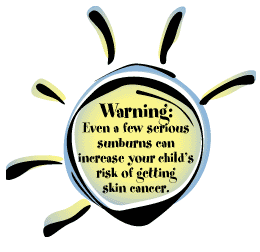|
|
||||||||||||||||
|
|
|
|
|
|||||||||||||
|
|
Control and Prevention Division of Cancer Prevention and Control 4770 Buford Hwy, NE MS K-64 Atlanta, GA 30341-3717 Call: 1 (800) CDC-INFO TTY: 1 (888) 232-6348 FAX: (770) 488-4760 E-mail: cdcinfo@cdc.gov Submit a Question Online |
|
|
|
Play It Safe in the Sun: A Guide for ParentsDownload a PDF version (147KB). Choose Your CoverHey Moms and Dads! Not all sun protection comes in a bottle. There are lots of ways to protect your child's skin all year long. Here are five you can try.
Sunscreen ScoopSunscreen may be easy, but it doesn't protect your child's skin completely. Try combining sunscreen with other "Choose Your Cover" options to prevent UV damage. Sunscreen comes in a variety of forms—lotions, sprays, wipes, or gels. Be sure to choose one made especially for kids with:
For most effective protection, apply sunscreen generously 30 minutes before going outdoors. And, don't forget to protect ears, noses, lips, and the tops of feet which often go unprotected. Take sunscreen with you to reapply during the day, especially after your child swims or exercises. This applies to "waterproof" and "water resistant" products as well. Keep in mind, sunscreen is not meant to allow your kids to spend more time in the sun than they would otherwise. Sunscreen reduces damage from UV radiation, it doesn't eliminate it. The American Academy of Pediatrics now advises that sunscreen use on babies less than 6 months old is not harmful on small areas of a baby's skin, such as the face and back of the hands. But your baby's best defense against sunburn is avoiding the sun or staying in the shade. 
Too Much Sun HurtsDid you know that just a few serious sunburns can increase your child's risk of skin cancer later in life? Kids don't have to be at the pool, beach, or on vacation to get too much sun. Their skin needs protection from the sun's harmful ultraviolet (UV) rays whenever they're outdoors. Turning pink? Unprotected skin can be damaged by the sun's UV rays in as little as 15 minutes. Yet it can take up to 12 hours for skin to show the full effect of sun exposure. So, if your child's skin looks "a little pink" today, it may be burned tomorrow morning. To prevent further burning, get your child out of the sun. Tan? There's no other way to say it—tanned skin is damaged skin. Any change in the color of your child's skin after time outside—whether sunburn or suntan—indicates damage from UV rays. Cool and cloudy? Children still need protection. UV rays, not the temperature, do the damage. Clouds do not block UV rays, they filter them—and sometimes only slightly. Oops! Kids often get sunburned when they are outdoors unprotected for longer than expected. Remember to plan ahead, and keep sun protection handy—in your car, bag, or child's backpack. Parents, help your children play it safe in the sun and protect your own skin as well. You're an important role model. When you play it safe, you're playing it smart. For more information about protecting your family from skin cancer, contact the National Cancer Institute's Cancer Information Service at 1-800-4-CANCER for information about all cancers, including skin cancer.
Page last reviewed: December 21, 2006
Page last updated: December 21, 2006 Content source: Division of Cancer Prevention and Control, National Center for Chronic Disease Prevention and Health Promotion |
|
|
|
|
||||||||||||
|